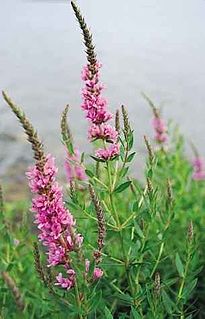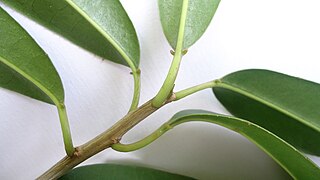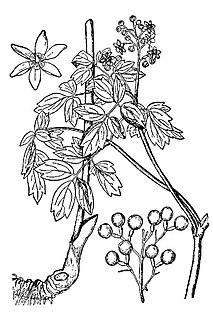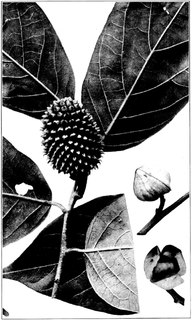
Lythraceae is a family of flowering plants, including 32 genera with about 620 species of herbs, shrubs and trees. The larger genera include Cuphea, Lagerstroemia (56), Nesaea (50), Rotala (45), and Lythrum (35). It also includes the pomegranate and the water caltrop. Lythraceae has a worldwide distribution, with most species in the tropics, but ranging into temperate climate regions as well.

The Annonaceae are a family of flowering plants consisting of trees, shrubs, or rarely lianas commonly known as the custard apple family or soursop family. With 108 accepted genera and about 2400 known species, it is the largest family in the Magnoliales. Several genera produce edible fruit, most notably Annona, Anonidium, Asimina, Rollinia, and Uvaria. Its type genus is Annona. The family is concentrated in the tropics, with few species found in temperate regions. About 900 species are Neotropical, 450 are Afrotropical, and the remaining are Indomalayan.

Sapium is a genus of flowering plants in the family Euphorbiaceae. It is widespread across most of Latin America and the West Indies. Many Old World species were formerly included in the genus, but recent authors have redistributed all the Old World species into other genera.

Nymphaea is a genus of hardy and tender aquatic plants in the family Nymphaeaceae. The genus has a cosmopolitan distribution. Many species are cultivated as ornamental plants, and many cultivars have been bred. Some taxa occur as introduced species where they are not native, and some are weeds. Plants of the genus are known commonly as water lilies, or waterlilies in the United Kingdom. The genus name is from the Greek νυμφαία, nymphaia and the Latin nymphaea, which mean "water lily" and were inspired by the nymphs of Greek and Latin mythology.

Polygala is a large genus of flowering plants belonging to the family Polygalaceae. They are commonly known as milkworts or snakeroots. The genus is distributed widely throughout much of the world in temperate zones and the tropics. The genus name Polygala comes from the ancient Greek "much milk", as the plant was thought to increase milk yields in cattle.

Chloranthaceae is a family of flowering plants (angiosperms), the only family in the order Chloranthales. It is not closely related to any other family of flowering plants, and is among the early-diverging lineages in the angiosperms. They are woody or weakly woody plants occurring in Southeast Asia, the Pacific, Madagascar, Central and South America, and the West Indies. The family consists of four extant genera, totalling about 77 known species according to Christenhusz and Byng in 2016. Some species are used in traditional medicine. The type genus is Chloranthus.

Caulophyllum is a small genus of perennial herbs in the family Berberidaceae. It is native to eastern Asia and eastern North America. These plants are distinctive spring wildflowers, which grow in moist, rich woodland, it is known for its large triple-compound leaf, and large blue, berry-like fruits. Unlike many spring wildflowers, it is not an ephemeral plant and persists throughout much of the summer. Common names for plants in this genus include blue cohosh, squaw root, and papoose root. As hinted at by its common names, this plant is well known as an alternative medicine for inducing childbirth and menstrual flow; it is also considered a poisonous plant.

Rollinia is a genus of plants in the family Annonaceae. While it is widely recognised as a distinct genus a recent monograph advocates its inclusion in Annona, which also contains custard apples and soursops.

Acradenia is a genus of two species of tree or shrub in the family Rutaceae and is endemic to Australia. These plants have leaves that are trifoliate, arranged in opposite pairs and flowers that have five sepals, five petals and usually ten stamens of unequal lengths.
This glossary of botanical terms is a list of definitions of terms and concepts relevant to botany and plants in general. Terms of plant morphology are included here as well as at the more specific Glossary of plant morphology and Glossary of leaf morphology. For other related terms, see Glossary of phytopathology and List of Latin and Greek words commonly used in systematic names.

Salvia is the largest genus of plants in the mint family, Lamiaceae, with nearly 1000 species of shrubs, herbaceous perennials, and annuals. Within the Lamiaceae, Salvia is part of the tribe Mentheae within the subfamily Nepetoideae. One of several genera commonly referred to as sage, it includes the widely produced herb used in cooking, Salvia officinalis.

Apodytes is a genus of flowering plants in the family Metteniusaceae. It was formerly either unplaced as to family or placed in the family Icacinaceae. It consists of about 8 species of evergreen trees, from tropical northeastern Australia, New Caledonia, Africa and Asia. The exact number of species has been revised from 3 to 8, according to The Plant List.

The Solanaceae, or nightshades, are a family of flowering plants that ranges from annual and perennial herbs to vines, lianas, epiphytes, shrubs, and trees, and includes a number of agricultural crops, medicinal plants, spices, weeds, and ornamentals. Many members of the family contain potent alkaloids, and some are highly toxic, but many—including tomatoes, potatoes, eggplant, bell and chili peppers—are used as food. The family belongs to the order Solanales, in the asterid group and class Magnoliopsida (dicotyledons). The Solanaceae consists of about 98 genera and some 2,700 species, with a great diversity of habitats, morphology and ecology.

Annona crassivenia is a species of plant in the family Annonaceae. It is native to Cuba. William Edwin Safford, the American botanist who first formally described the species, named it after the thick tertiary veins that interconnect the secondary veins of its leaves.

Annona jahnii is a species of plant in the family Annonaceae. It is native to the Brazil, Colombia and Venezuela. William Edwin Safford, the American botanist who first formally described the species, named it after the Venezuelan scientist, explorer and mountain climber Alfredo Jahn.

Fusaea longifolia is a species of plant in the family Annonaceae. It is native to Brazil, Colombia, Ecuador, French Guiana, Guyana, Peru, Suriname and Venezuela. Jean Baptiste Christophore Fusée Aublet, the French botanist who first formally described the species using the basionym Annona longifolia, named it after its long-leaved foliage.
Fusaea decurrens is a species of plant in the family Annonaceae. It is native to Peru. Robert Elias Fries. The Swedish botanist who first formally described the species, named it after wings of the leaves that run down the stem of the leaf.
Fusaea peruviana is a species of plant in the family Annonaceae. It is native to Brazil, Colombia, Ecuador and Peru. Robert Elias Fries, the Swedish botanist who first formally described the species, named it after Peru where the specimen he examined was found near the Huallaga River and the city of Yurimaguas.
Mischogyne is a genus of plants in the family Annonaceae. It comprises five species distributed in Angola, Cameroon, Gabon, Ghana, Guinea, Guinea-Bissau, Ivory Coast, Liberia], Nigeria, Sierra Leone, Democratic Republic of the Congo. Arthur Wallis Exell the British botanist who first formally described the genus named it after the stalks that bears its reproductive structures.














